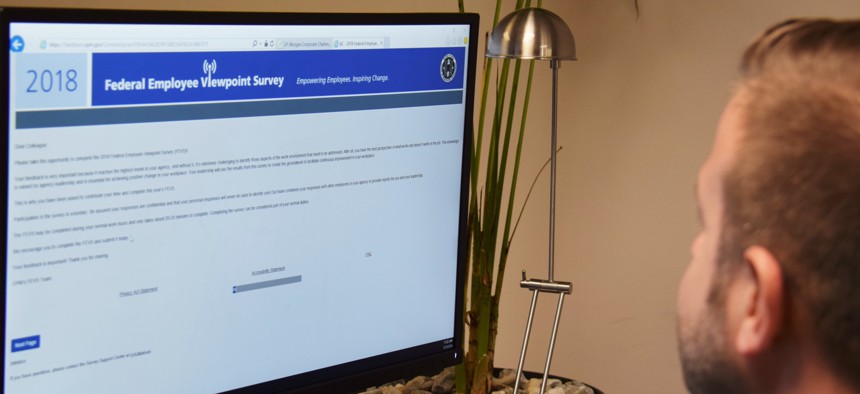
A federal employee viewing the Federal Employee Viewpoint Survey on a computer on May 15, 2018. In the absence of this year's FEVS, the Partnership for Public Service has created its own version of the survey. Smith Collection / Gado / Getty Images
Nonprofit launches FEVS alternative after OPM’s cancellation of official survey
The Public Service Viewpoint Survey aims to at least partially fill the void left by the Federal Employee Viewpoint Survey, which OPM cancelled this year despite a legal requirement that it be administered annually.
The Partnership for Public Service this week launched a new survey of federal employees’ morale and attitude toward work, in an effort to maintain some level of data continuity after the Office of Personnel Management cancelled this year’s iteration of the Federal Employee Viewpoint Survey.
When OPM first confirmed in August that it would forego the annual survey in 2025, despite being required by law to administer it, officials said the year off was necessary to remove diversity-related questions. Critics at the time questioned that rationale and suggested the actual motive is fear of results that may prove “embarrassing” to the White House.
Enter the Public Service Viewpoint Survey. Administered by the Partnership for Public Service, a nonpartisan good government advocacy group that each year compiles the Best Places to Work in the Federal Government rankings based on FEVS data, the poll asks an abridged list of questions taken mostly verbatim from OPM’s annual survey.
“It’s a balance,” said Michelle Amante, senior vice president of government programs for the Partnership. “We wanted to try to replicate the most important questions, while being cognizant of the fact that survey length has been an issue for feds for many years. There were 90 viewpoint questions [on the last FEVS] and so what we did was we took that down to 23 questions, and of the 23, 19 are pulled directly from the FEVS.”
Traditionally, when OPM administers the FEVS, employees must use a federal government computer to access and fill out the survey. Without that backstop to ensure all respondents are federal employees, the Partnership developed questions at the start of the survey to try and verify participants’ relation to the federal government, and the organization is encouraging feds to fill it out outside of work hours, since it is not an official government survey. The group is also working with unions and other federal employee groups to solicit workers’ responses.
But those constraints also present new opportunities. For years, FEVS data has had an overrepresentation of managers and executives, compared to their overall proportion of the federal workforce, because many frontline federal workers do not have regular computer access during their shifts.
“If you think about the people in VA hospitals, or the National Park Service or TSA, it can be very difficult for them to fill out the survey [during work hours],” Amante said. “With ours—for one, you can do it on a phone, which has always been a barrier for the FEVS—they can do it whenever . . . They can take it on the weekend or in the evening. It opens up accessibility in new ways.”
The survey runs from now until Dec. 19. In just the first two days since its launch, it has already garnered more than 5,000 responses, and the Partnership hopes to begin releasing data by early next year.
“We don’t know yet whether we’ll be able to do the rankings at this point—it depends on the responses we get, and we would have to have really strong representation across multiple agencies,” Amante said. “So whether or not it ends up being the full rankings, we will have some sort of Best Places release in early March.”
Share your news tips with us: Erich Wagner: ewagner@govexec.com; Signal: ewagner.47







